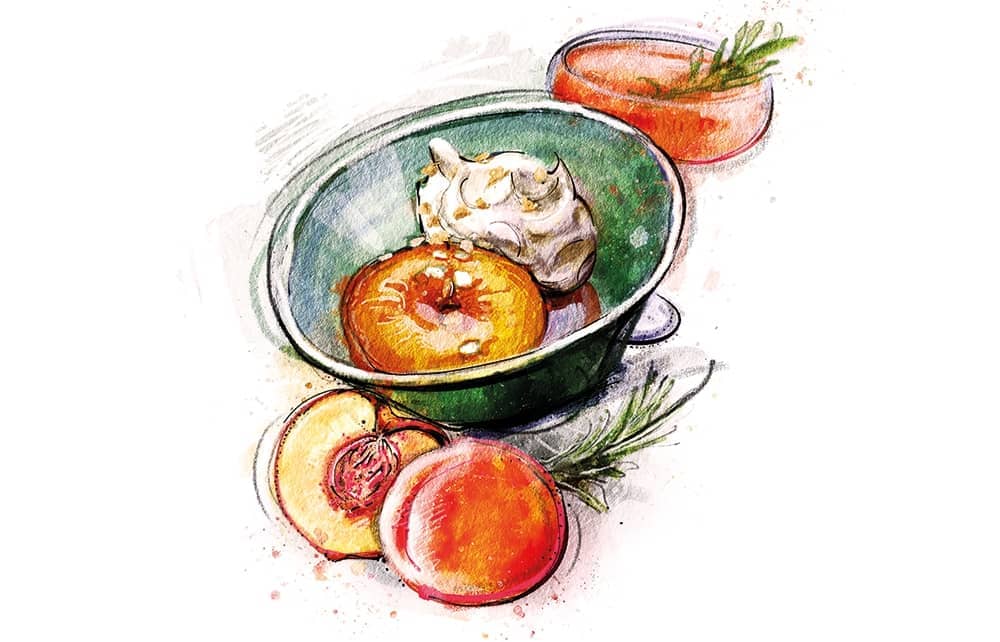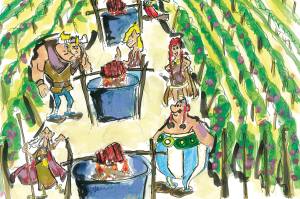I’ve never been very good at leaving things be. I tend to gild the lily. I may plan to do something simple, but I always find myself adding to it, primping, dithering. This is true in every area of life, but never more so than when I’m cooking.
For that reason, this time of year can make me a little uncomfortable. When summer arrives in earnest — as opposed to those brief, misleadingly sunny weekends of late April and mid-May — Britain is inundated with beautiful fresh fruit. Right now, it’s strawberries, gooseberries, peaches and cherries; raspberries, blackcurrants and figs are just around the corner. And we are told over and over that it is impossible to improve on ripe, raw fruit, fresh from the tree.
But I promise you (and this is not just me being a fusspot): there are occasions when it is worth cooking ripe, seasonal fruit; where it improves the fruit, and heightens its deliciousness. Even the loveliest strawberries become more fragrant, brighter, when macerated with the smallest amount of sugar; stewing gooseberries tempers their acidity, balancing it; cooked blackberries smell of violets and taste of wine. And a peach, poached, is an impossibly elegant pudding.
A poached peach is calmer than a fresh one, less extroverted: it won’t splurge its juices over you. Instead, all those juices are contained, as if the flavor has been concentrated. It’s prettier too (although to say so may be sacrilege): blanching the peaches before poaching makes them easy to peel, but has the added advantage that the rosy pink of the skin stains the flesh a beautiful blush.
There is something pleasing about serving a whole, intact peach, like presenting a whole world in a bowl. But if you don’t fancy having to contend with a stone when eating, you can halve and pit the fruit before poaching: just reduce the cooking time to ten minutes. If you’re on the fence, though, leave it in — the pit will impart a subtle almond flavor, and a very slight bitterness.
Once the peaches are poached, you lift them out of their poaching liquor, and boil the liquid hard until the tiny bubbles grow into bigger, volcanic ones, and it transforms into a thick, coral-colored syrup.
For the aromatics in the syrup, I’ve stayed classic, and added a little honey, thick swatches of lemon peel, some vanilla and rosemary. But a poaching syrup is a blank canvas for imparting flavor: bay leaf will bring a mellow summer taste, floral and herbal, and somehow green; cracked cardamom pods make a syrup earthy and musky, while black peppercorns give spice; a small pinch of saffron will turn the syrup and peaches bright orange, and add its distinctive sweet-strange metallic flavor. Hard herbs (rosemary, thyme, bay) hold up better to simmering than softer herbs, but mint, basil and tarragon will still impart beautiful flavor — they are just better added at the very last moment to the peaches, otherwise they can discolor and become soggy. A tiny splash of rose water or orange blossom water is a beautiful addition to any poaching syrup.
You can jazz up the finished pudding as much or as little as you fancy: I often serve it alone, in a glass, with the cool syrup spooned on top. It is perfect straight from the fridge, slippery and cold, when the summer evening is still hot and close. But it sits beautifully alongside thick, slightly whipped, unsweetened cream, or really good vanilla ice cream. If I’m feeling fancier, I like it piled up on big, blousy meringues, or with chopped, sprinkled toasted nuts (pistachios and hazelnuts are my favorites) or crumbled amaretti biscuits. Although traditionally peach melba was made with fresh peaches, poached peaches are often now used — just add raspberry coulis and vanilla ice cream.
However you serve the peaches, you should pour the syrup generously over them — but you’ll still likely end up with some left over. Repurpose this for cocktails, spritzes, or just use as a cordial with sparkling water for the prettiest pale pink drink around.
Serves 4
Takes twenty minutes, plus chilling time
4 peaches
15 fl oz Riesling or Moscato
3½ caster sugar
1 tbsp honey
2 sprigs rosemary
1 large piece lemon peel
1 vanilla pod, halved and seeds scraped out
- Cut a cross into the base of each peach then pour enough boiling water over the top of the peaches to submerge them. Leave them for two minutes, then drain off the hot water, and peel the peaches — the skin should now come away easily
- Place the wine, sugar, honey, rosemary, vanilla seeds and pod and lemon peel in a small pan, and simmer until the sugar has dissolved. Put the four peeled peaches in the pan, cover with a tight lid, and simmer for fifteen minutes. Carefully lift the peaches from the liquid and set to one side in a bowl.
- Bring the poaching liquor to a rolling boil, and boil it for ten minutes until it is reduced and syrupy. Pour the syrup over the peaches, and leave everything to cool completely before serving
This article was originally published in The Spectator’s UK magazine. Subscribe to the World edition here.


















